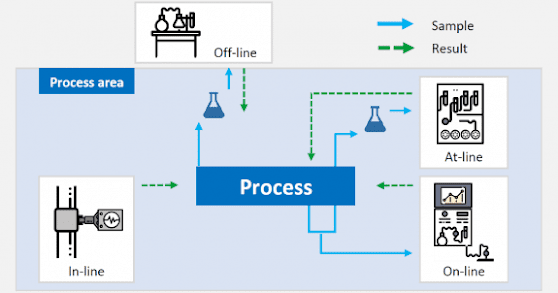Chemical Oxygen Demand (COD) – Methods, Measurement, Uses, Procedure, Calculation
Chemical Oxygen Demand (COD) is a second method of estimating how much oxygen would be depleted from a body of receiving water as a result of bacterial action. While the BOD test is performed by using a population of bacteria and other microorganisms to attempt to duplicate what would happen in a natural stream over a period of five days, the COD test uses a strong chemical oxidizing agent (potassium dichromate or potassium permanganate) to chemically oxidize the organic material in the sample of wastewater under conditions of heat and strong acid. The COD test has the advantage of not being subject to interference from toxic materials, as well as requiring only two or three hours for test completion, as opposed to five days for the BOD test. It has the disadvantage of being completely artificial, but is nevertheless considered to yield a result that may be used as the basis upon which to calculate a reasonably accurate and reproducible estimate of the oxygen-demanding properties of a wastewater. The COD test is often used in conjunction with the BOD test to estimate the amount of nonbiodegradable organic material in a wastewater. In the case of biodegradable organics, the COD is normally in the range of 1.3 to 1.5 times the BOD. When the result of a COD test is more than twice that of the BOD test, there is good reason to suspect that a significant portion of the organic material in the sample is not biodegradable by ordinary microorganisms. As a side note, it is important to be aware that the sample vial resulting from a COD test can contain leachable mercury above regulatory limits. If such is the case, the sample must be managed as a toxic hazardous waste.
The COD test is commonly used to indirectly measure the amount of organic compounds in liquid waste. It is expressed in milligrams/grams/liter (mg/L or g/L respectively), which indicates the mass of oxygen that would be consumed per liter of solution to fully oxidize its components (expression as parts per million (ppm) is also possible). COD is determined using Hach tubes and a method based upon the reduction of (orange) potassium dichromate to (green) chromium salts at high temperatures, followed by absorbance measurement using a dedicated colorimeter. The method has been chosen by the water industry as a standard, and is available from CHEMetrics USA as a USEPA-approved dichromate reactor digestion method, described in ISO 6060. Potassium dichromate is a strong oxidizing agent under acidic conditions. Acidity is usually achieved by the addition of sulfuric acid. In the process of oxidizing the organic substances found in a water sample, potassium dichromate is reduced, forming chromium (III) ions, Cr3+. The amount of Cr3+ is determined after oxidization is complete, and is used as an indirect measure of the organic contents of the water sample. One of the main limitations of the COD test is its inability to differentiate between biodegradable and biologically inert organic matter on its own. The use of chemicals such as chromium and strong acids produce hazardous liquid waste, which requires careful disposal. A blank sample is usually created by adding all reagents to a volume of distilled water. COD is measured for both the polluted water and blank samples, and the oxygen demand in the blank sample is subtracted from the COD for the original sample to ensure a true measurement of organic matter.
What is Chemical Oxygen Demand (COD)?
- Chemical oxygen demand refers to the amount of oxygen required for the chemical oxidation of organic and inorganic components present in wastewater with oxidising agents such as potassium permanganate, potassium dichromate, etc.
- When COD is present, the chemical oxidation of organic matter is accelerated without the need for extra equipment.
- This is the only approach for determining the organic load in very toxic sewage.
- To measure COD, the water sample is placed in a closed container and subjected to a potent oxidant, such as potassium dichromate and sulfuric acid, for the specified duration and temperature.
- The COD is the quantity of oxygen required by both the inorganic and organic components of the wastewater sample.
- When treated wastewater is put back into the environment, it can put organic materials into the water nearby.
- High COD concentrations in wastewater indicate the presence of organic substances that may lower the amount of dissolved oxygen.
- Typically, this has negative impacts on the environment and regulatory obstacles.
- Oxygen demand is a critical metric for analysing the impact of organic pollution in water and, eventually, reducing its amount.
Measurement of COD
- There are a number of approaches that can be used to calculate COD.
- Online testing and off-line laboratory approaches employing environmental analyzers are examples.
- In the presence of a powerful oxidising agent in an acidic environment, virtually any organic component will oxidise to carbon dioxide, according to the COD testing method.
- The COD analysis will determine the equivalent oxygen concentration required to chemically oxidise organic molecules in water.
- Environmental analyzers are sophisticated scientific instruments utilised in contemporary COD testing processes.
- The EasyPREP COD-200 is a technological pioneer in this field. COD sample mixes are heated, cooled, and then evaluated throughout this procedure.
Methods to Reduce COD in Wastewater
There are many ways that have been shown to reduce COD in the management of wastewater. Wastewater Separation (coagulation and flocculation) and COD removal by microbial action are two of the most common ways to get rid of COD in wastewater.
Wastewater Separation
- Using coagulation and flocculation during the treatment of wastewater, wastewater separation techniques remove colloidal particles.
- During coagulation, a non-toxic agglomerating agent is added to the water to clump together all the suspended particles so that they may be easily filtered out of the wastewater. Such agents include ferric chloride (FeCl) and alum, among others.
- By creating bigger particles, or flocs, flocculation uses a chemical polymer (flocculating agent) to remove clumped particles from water.
- After being placed in a sedimentation tank for extra treatment prior to disposal, flocs undergo sedimentation in the wastewater treatment process.
- By eliminating organic materials from wastewater with coagulants and flocculants, the competition for dissolved oxygen between marine life and bacteria is lessened, as microorganisms no longer have “food” to thrive.
By Microbial Action
- Another successful method for COD removal is the addition of bacteria or other microbes that degrade organic components in wastewater.
- There are both aerobic and anaerobic bacteria in sewage treatment.
- Introducing bacteria or other microorganisms that decompose organic waste-derived compounds into carbon dioxide and water when air is present is aerobic COD removal.
- Ideal COD treatment for wastewater with COD levels below 3000 mg/L is aerobic COD treatment.
- For anaerobic COD removal, microorganisms are used to turn organic waste components into biomass in the absence of oxygen.
- This technique produces ethanol that may be utilised as an alternative energy source for power, heating, and drying, making it a highly useful method.
- COD levels more than 2,000 mg/L are suitable for anaerobic COD treatment
COD – Uses
COD is a key indicator of water quality and is applied in a
variety of applications, including the following:
Chemical Oxygen Demand measures are used to quantify the biodegradable component of wastewater effluent; COD measurements are also used as an estimate of the size of a wastewater treatment facility required for a specific area.
Challenges Associated with COD Monitoring
- Due to the two-hour delay between delivery to the laboratory and testing, environmental harm can occur before the results are available.
- The exam is expensive and time-consuming.
- The test entails the use of hazardous chemicals that must be disposed of properly and may constitute a risk to the operators.
- It does not simulate natural processes (for example, the test involves an artificial incubation with a strong oxidising agent).
- It is inaccurate and has a low limit of detection. Therefore, it is inapplicable to river samples that are clean and uncontaminated.
Determination of Chemical Oxygen Demand of Wastewater
Principle
In the presence of sulfuric acid, silver sulphate, and
mercury sulphate, potassium dichromate oxidises the organic matter contained in
the water sample to produce carbon dioxide (CO2) and water (H2O). The amount of
potassium dichromate utilised is determined by comparing the volumes of ferrous
ammonium sulphate consumed during blank and sample titrations. The amount of
potassium dichromate used in the reaction is equivalent to the amount of oxygen
(O2) required to oxidise the wastewater’s organic content.
Requirement
Preparation of Potassium dichromate (K2Cr2O7) Solution
- Add 6,13 g of dried at 105 °C for at least two hours potassium dichromate to 800 ml of distilled water.
- Shake the flask vigorously to dissolve the contents, then add 1000 ml of water and combine thoroughly.
Preparation of Silver sulfate-Sulfuric acid Solution
- Dissolve 10 grammes of silver sulphate (Ag2SO4) in 500 millilitres of concentrated sulfuric acid and bring the total volume to one thousand millilitres.
- Allow the solution to stand for 24 hours before to use.
Preparation of Mercury sulfate Solution
- Dissolve with care 0.1 grammes of HgSO4 in 5 millilitres of sulfuric acid.
Preparation of Ferrous ammonium sulfate Solution (0.025
M)
- Dissolve 9.8 grammes of ferrous ammonium sulphate in 100 millilitres of distilled water and 20 millilitres of sulfuric acid.
- Cool the solution and dilute it with 1,000 millilitres of distilled water.
- Determine the actual concentration of the solution in order to compute the chemical oxygen demand by standardising it.
Preparation of Ferroin Indicator
400 ml of purified water should be mixed with 3.5 grammes of
Iron Sulfate heptahydrate and 7.5 grammes of Phenanthroline monohydrate.
Mix thoroughly to dissolve, and add enough pure water to
reach 500 ml.
Test Procedure for Chemical Oxygen Demand:
- Place 10 ml of sample in a flask with a circular bottom.
- Add some glass beads to keep the solution from contacting the flask while it is being heated.
- Mix 1 ml of Mercury sulphate (HgSO4) solution by rotating the flask.
- Add 5 ml of a solution of potassium dichromate (K2CrO7).
- Now add 15 ml of Silver sulfate-sulfuric acid solution slowly and cautiously.
- Connect the reflex condenser and digest the contents for two hours on a hot plate.
- After digestion, rinse the condenser with 25 ml of distilled water collected in the same flask.
- Add 2-4 drops of ferroin indicator to the flask and titrate to the endpoint with 0.025 M ferrous ammonium sulphate solution.
- Prepare the blank in the same manner as the sample, substituting distilled water for the sample.
Calculation
Determine the chemical oxygen requirement using the
following formula:
COD = 8x1000xDFxMx(VB – VS)/Volume of sample (in ml)
Where,
- DF – Factor of Dilution (if applicable)
- M – Molarity of a standard solution of Ferrous Ammonium Sulfate
- VB – Volume consumed during titration with blank solution
- VS – Volume utilised during titration sample preparation
Example Calculation
- Sample (VS) ferrous ammonium sulphate volume = 23,8 ml
- Ferrous ammonium sulphate volume for Blank VB) = 25.6 ml
- 1 is the Dilution Factor (DF) (sample used as it is)
- COD = 8x1000x1x0.025x(25.6-23.8)/10
- = 8000×0.025×1.8/10
- = 360/10 = 36 mg/lit or ppm
References
Hu, Z., & Grasso, D. (2005). WATER ANALYSIS | Chemical
Oxygen Demand. Encyclopedia of Analytical Science, 325–330.
doi:10.1016/b0-12-369397-7/00663-4
https://www.scimed.co.uk/education/what-is-chemical-oxygen-demand-cod/
https://www.corrosionpedia.com/definition/3207/chemical-oxygen-demand-cod
https://www.hach.com/parameters/chemical-oxygen-demand
https://realtechwater.com/parameters/chemical-oxygen-demand/
https://aosts.com/how-to-reduce-chemical-oxygen-demand-cod-in-wastewater/
https://prepp.in/news/e-492-chemical-oxygen-demand-cod-environment-notes
https://www.sigmaaldrich.com/IN/en/technical-documents/technical-article/environmental-testing-and-industrial-hygiene/waste-water-and-process-water-testing/chemical-oxygen-demand













No comments